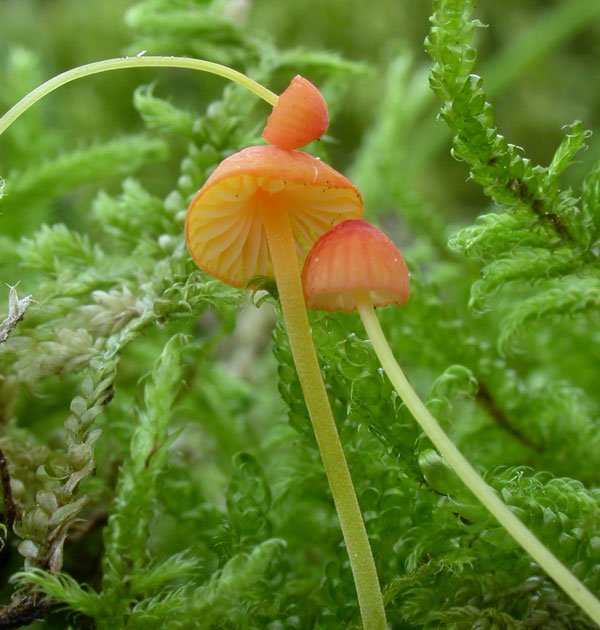On fallen twigs, plant debris, and decayed wood of deciduous
trees, rarely from conifers, mostly in humid places. Often together with M
speirea. Early summer to late autumn. Common in Europe and widely distributed
in Norway, but more rare in boreal and alpine zones.
Pileus 2-6(-8) mm
across, hemispherical, broadly conical to parabolical, shallowly sulcate, translucent-striate,
slightly viscid, deep orange-red, fading to orange or more yellowish. Lamellae 9-16 reaching the stipe, ascending, narrowly adnate to adnate, orange-yellow to whitish. Stipe 20-35 x 0.3-0.5(-1) mm, straight to flexuous, entirely pruinose, orange-yellow to yellow,
paler at the apex, the base covered with long, flexuous,
white fibrils, at times somewhat rooting. Odour indistinctive.
Basidia 19-24 x 6-7 µm, clavate, 4-spored. Spores 8.5-11(-12) x (3-)3.5-5
µm, Q = 2.4-3.3, Qav 2.6-2,8, narrowly pip-shaped, smooth, non-amyloid. Cheilocystidia 15-25 x 5-9 µm, occuring mixed with the basidia, but partly forming a sterile band, clavate, fusiform, lageniform, subcylindrical,
smooth. Pleurocystidia similar. Lamellar trama non-dextrinoid. Hyphae of the pileipellis 1.5-3.5 µm wide, overlying a pseudoparenchymatous hypoderm, covered with simple, cylindrical excrescences 2-9 x 1-3 µm. Hyphae of the cortical layer of the
stipe up to 4.5 µm wide, covered with simple to somewhat branched, cylindrical to inflated excrescences 2-22 x 1-5 µm, embedded in gelatinous matter. Clamp connections present in all tissues.
This beautiful, tiny Mycena usually
causes no trouble to determine. It is characterized
by the small size, the orange-red pileus, the white to yellow
lamellae, and the yellowish stipe. It is the monotype of
sect. Aciculae Kühner ex Singer.
Atheniella adonis, 'Mycena floridula', and A.
leptophylla are larger, bright coloured species. Among other differences the hyphae of the cortical layer of the stipe are smooth. Mycena oregonensis is somewhat similar but the pileus is more yellow, the
lamellae are broadly adnate or decurrent with a short tooth,
and the lamellar edge is orange to bright yellow; the hyphae
of the cortical layer of the stipe are smooth and not embedded
in gelatinous matter, and in European collections the basidia
are 2-spored and devoid of clamps. Mycena
strobilinoides Peck,
an American species reported by Robich (2003) from Italy
and from Switzerland by Métrod, looks similar with
its orange cap. It differs, however, among several features,
by the cheilocystidia which are densely covered by excrescences.

|